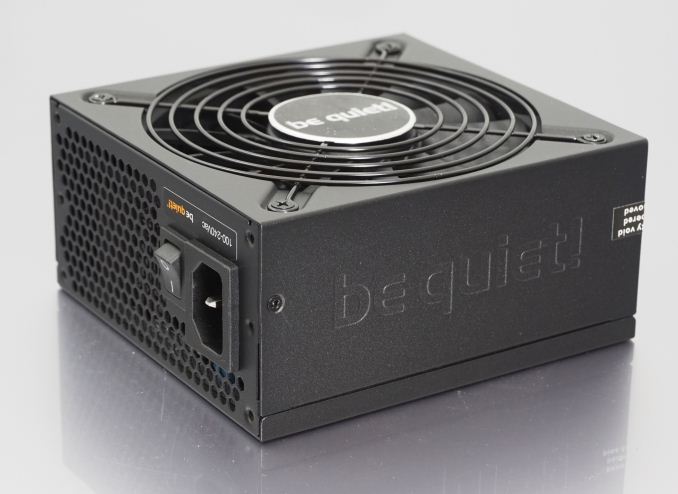High performance entertainment and gaming PCs are slowly but steadily increasing their presence into modern living rooms. This is largely attributed to the development of compact and powerful components that made small form factor (SFF) gaming PCs an affordable option. Although it is difficult to build a powerful gaming system as small as a gaming console, the development of aesthetically alluring SFF cases, in combination with the versatility and other advantages that PCs have, is turning them into a very serious competitor with gaming consoles.
As compact and unique home entertainment and gaming systems are gaining ground, so do the SFX power supply units. PC components are not only becoming more powerful but also more efficient, lowering the power requirements of typical gaming systems. At the same time, power supply units (PSUs) are also becoming more efficient, smaller, and affordable. Thus, advanced SFX PSUs are increasing their market share, with increasingly more manufacturers adopting them into their products lineup.
In today’s review we are taking a look at the latest SFX PSU from Be Quiet!, the SFX-L Power 500W. The German manufacturer specializes on PC cases, cooling and PSUs. As the company name suggests, their products are primarily designed with acoustics performance in mind. According to the manufacturer, they designed their new SFX-L Power units to power modern living room entertainment and gaming systems just as well as an equivalent ATX PSU would, including whisper-quiet operation. The Be Quiet! SFX-L Power also is reasonably priced for an 80Plus Gold certified, fully modular SFX PSU. We will closely examine its quality and overall performance in the following pages of this review.
| Power specifications ( Rated @ 40 °C ) |
| AC INPUT |
100 – 240 VAC, 50 – 60 Hz |
| RAIL |
+3.3V |
+5V |
+12V |
+5Vsb |
-12V |
| MAX OUTPUT |
20A |
20A |
41.7A |
3A |
0.3A |
| 105W |
500W |
15W |
3.6W |
| TOTAL |
500W |
As always, Be Quiet!’s dark packaging is aesthetically minimalistic, with just a simple picture of the PSU breaking coldness of the all-black theme. However, its thick walls and polystyrene foam slabs offer ample shipping protection to the small unit.
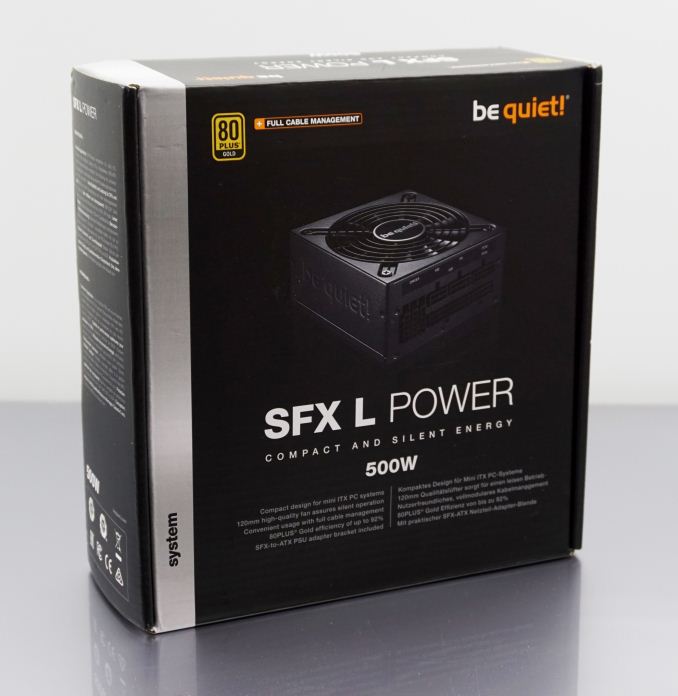
The bundle of the SFX-L Power 500W unit is very basic, limited to just the necessary AC power cable, four silver mounting screws, and a typical user’s manual. There are no cable ties, cable straps, or other accessories. However, Be Quiet! included an SFX to ATX adapter plate, allowing the SFX-L Power 500W to be installed into ATX cases. It is interesting to note that the adapter has holes to support the PSU with its fan facing either upwards or downwards, allowing it to be installed in either orientation inside an ATX case.

With the SFX-L Power 500W being an all-modular design, every cable can be detached, including the 24-pin ATX cable. All of the cables are ribbon-like, “flat” type, which is the reasonable choice considering that the PSU may be installed in very confined spaces where every millimeter counts. Note that these cables are much shorter than those of a regular ATX unit, with the ATX cable being just 30 cm (11.8″) long and the PCIe cables only 40 cm (15.75″) long, which could make the installation of the SFX-L Power 500W inside a large ATX case highly problematic. Every cable is made of black wires and black connectors. It is also interesting to note that this particular model has four 6+2 pin PCIe connectors, which we rarely see on PSUs with an output below 600 Watts.
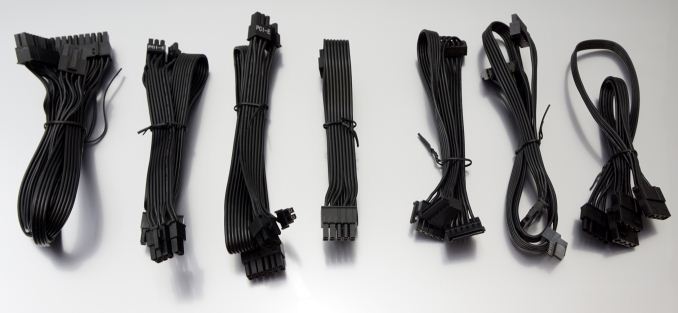
| Be Quiet! SFX-L Power |
| Connector type |
Hardwired |
Modular |
| ATX 24 Pin |
– |
1 |
| EPS 4+4 Pin |
– |
1 |
| EPS 8 Pin |
– |
– |
| PCI-E 6+2 Pin |
– |
4 |
| PCI-E 8 Pin |
– |
– |
| SATA |
– |
6 |
| Molex |
– |
3 |
| Floppy |
– |
– |
An experienced eye will instantly identify that the SFX-L Power 500W is significantly longer than a standard SFX PSU. The chassis is measuring 125 × 63.5 × 130 mm / 4.92 × 2.5 × 5.12 in (W×L×D), which is 30 mm deeper than a standard SFX-compliant unit. Be Quiet! forgoes the SFX specification limits for their 500W and 600W SFX units to fit 120 mm fans, as acoustics performance is of utmost importance to the company. We have seen what high-output SFX units can do with 80 mm fans, so we are hoping to see the SFX-L Power 500W doing better.
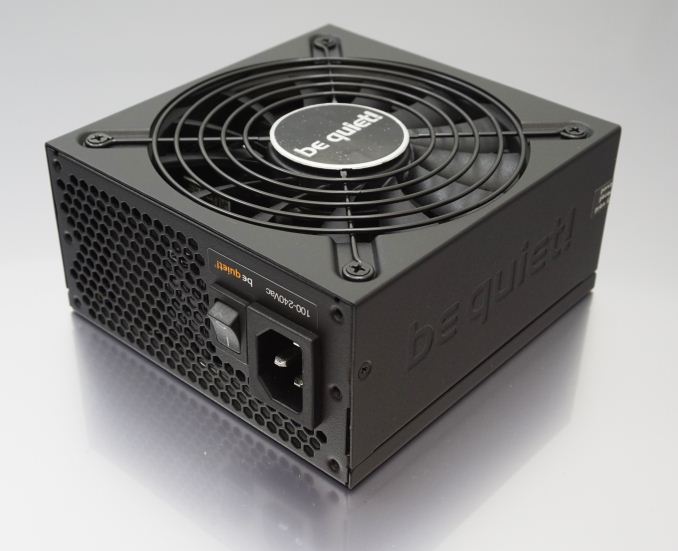
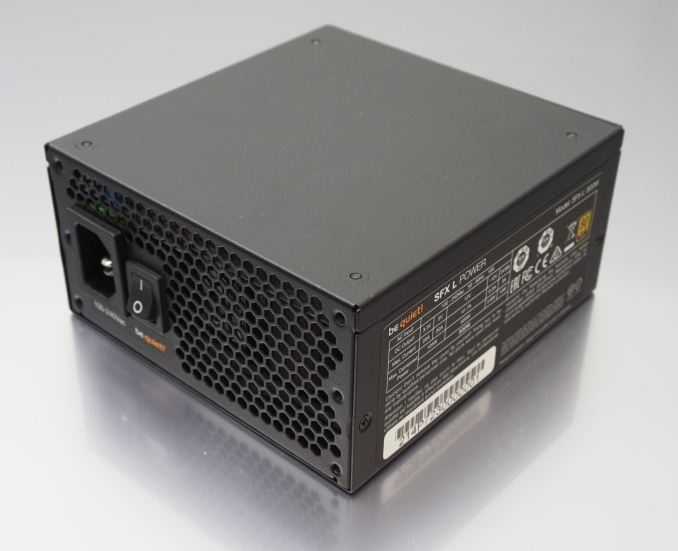
The Be Quiet! SFX-L Power 500W PSU is a very subtle, all-black design. The chassis is sprayed with a matte black paint, the connectors/plastics are all black, and even the fan’s finger guard is satin black. Only the chrome letters and surround of the round company badge at the center of the guard breaks the monotony. The company name is embossed on the right side of the unit and a sticker with its electrical specifications and certifications can be found on the left.
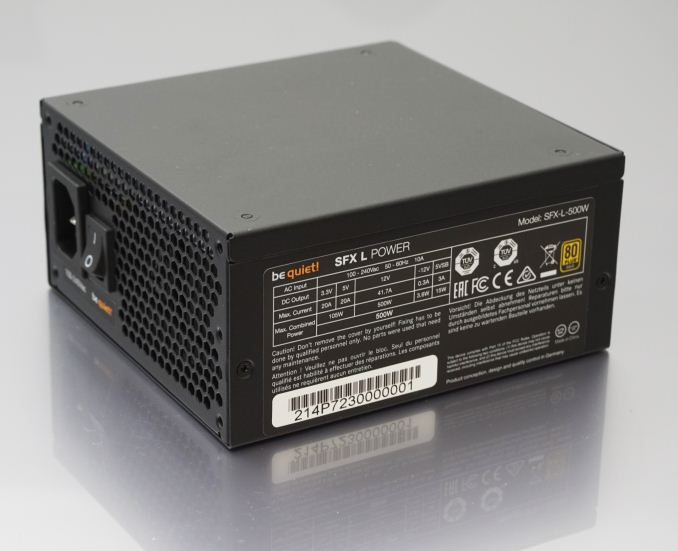
On the rear side of the Be Quiet! SFX-L Power we can see an AC cable receptacle and a small switch. The switch is actually a surprise, as many manufacturers omit them on their SFX units due to space limitations. The front side is filled with the connectors for the modular cables, plus a peculiarly simplistic sticker that serves as a very basic legend. All of the cables, including the PCIe and the CPU 12V cables, have different connectors and cannot be mismatched.
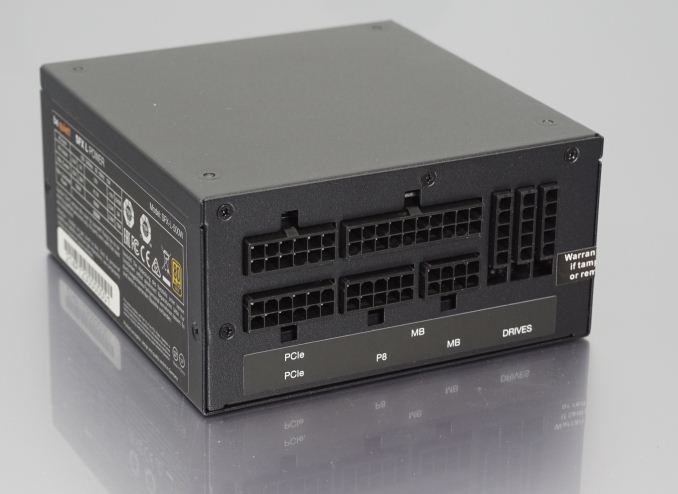
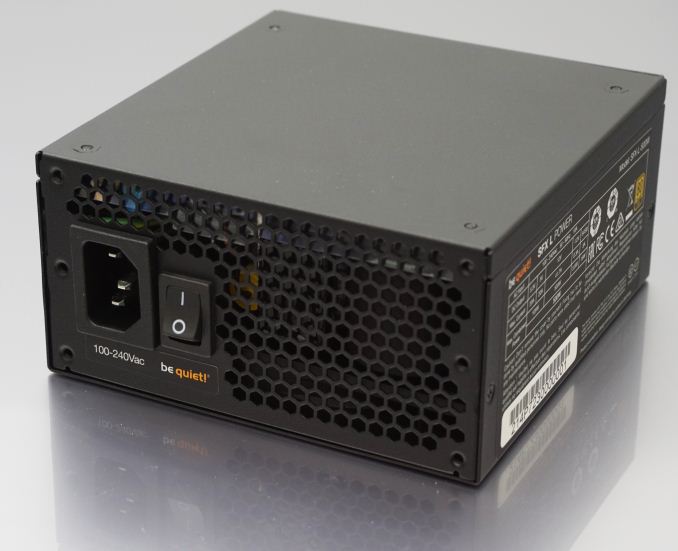
The highlight of this PSU, the 120 mm fan, is made by Globe. It is a low-profile model with a high quality fluid dynamic bearing (FDB) engine. FDB fans are frequently used for applications where longevity needs to be combined with low noise operation. It has a maximum speed of about 1850 RPM at 12 Volts. Keep in mind that there is no correlation between the performance of low-profile fans and normal 25 mm wide fans, as their aerodynamic characteristics differ greatly. You should not compare the airflow or acoustics of this fan to any 25 mm wide fan simply because they share a similar rotational speed. The narrow, multi-bladed model that Be Quiet! is using will have relatively good airflow but very poor static pressure characteristics.
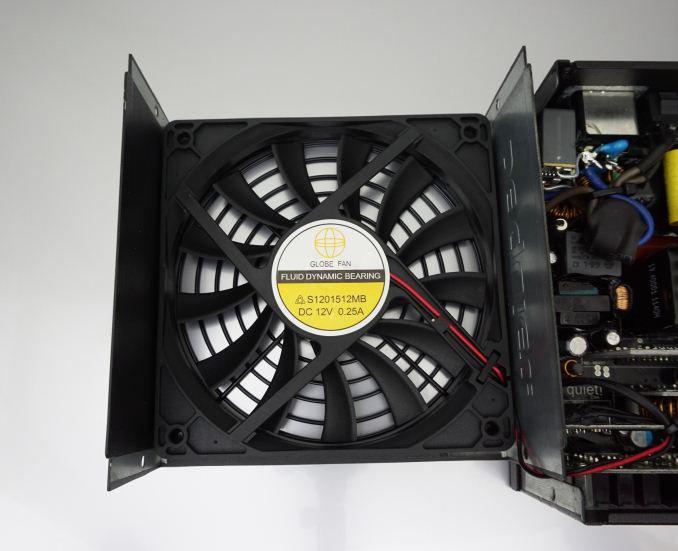
Be Quiet! entrusted their SFX units to High Power, a known OEM who often is behind the German company’s PSUs. High Power is also often referred to as “SIRFA”, which is their parent company. We frequently find their platforms in middle and high output designs.
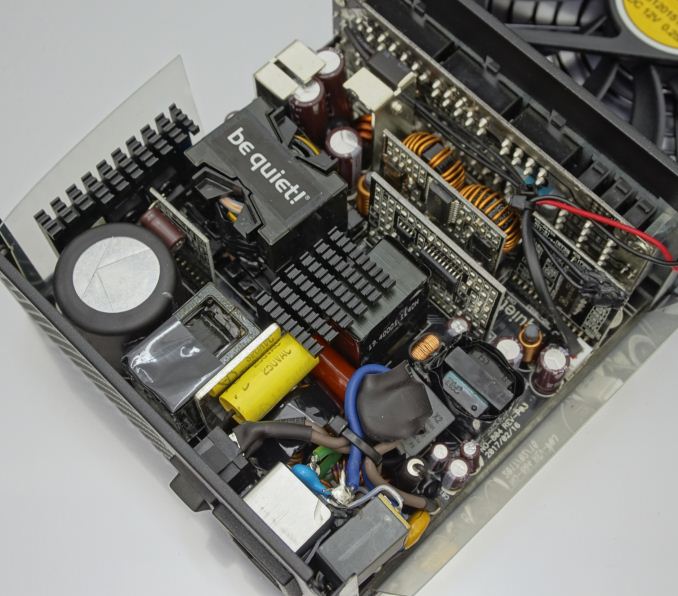
The filtering stage begins at the back of the AC receptacle and continues onto the main PCB, with a total of four Y capacitors, two X capacitors, and two filtering inductors packed closely together. A single rectification bridge can be found on the very basic, unpainted heatsink. A bulky 420V/390μF capacitor from Rubicon wrapped in heatshrink and a shielded inductor are the passive components of the APFC stage.
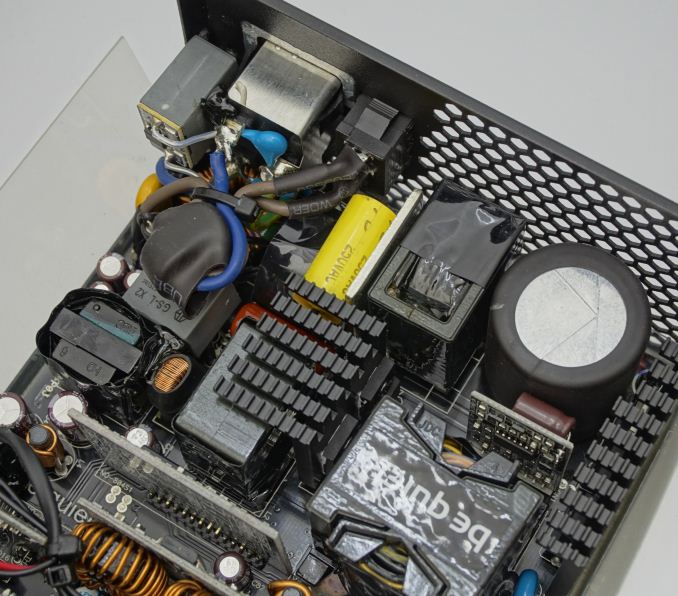
Two MOSFETs are the active components of the LLC resonant half-bridge primary inversion stage. The secondary side MOSFETs that generate the single 12V line are placed on the underside of the PCB, with thermal pads assisting their cooling by transferring a portion of their thermal losses to the chassis. The two silver heatsinks that can be seen near the connectors PCB cover most of the cooling needs of the secondary side MOSFETs. The 3.3V and 5V lines are being generated “on-demand” via DC-to-DC conversion circuits.
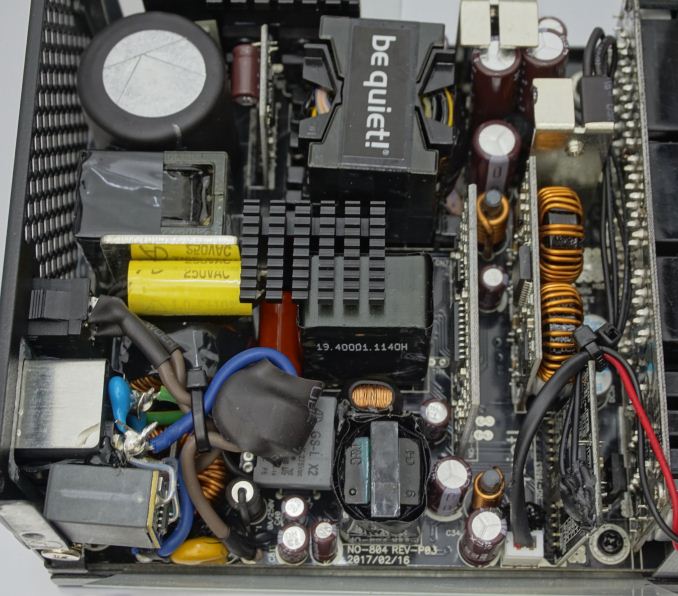
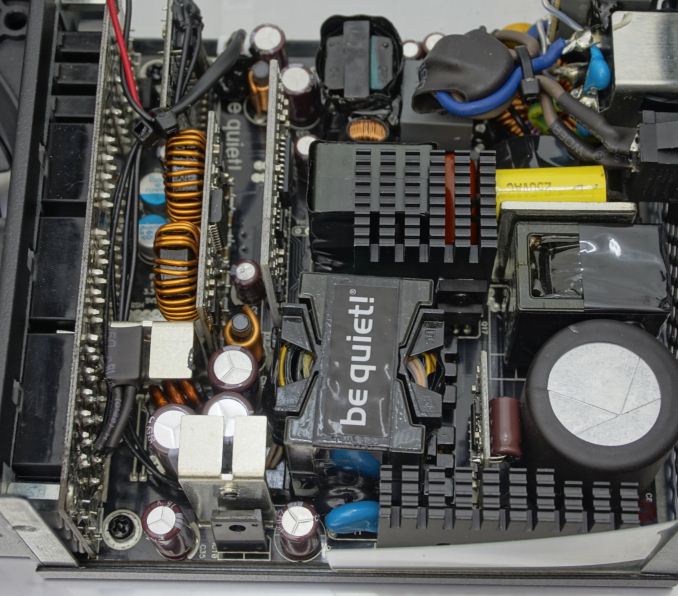
The heatsinks inside the Be Quiet! SFX-L Power 500W unit are relatively small, even for an SFX PSU, but they should provide more than enough heat dissipation surface for the cooling needs of the unit. Most of the capacitors on the main PCB are electrolytics, with just a few polymer capacitors behind the minor voltage line filtering inductors. Several more polymer capacitors can be found onto the connectors PCB, filtering the outputs of the unit. All of these capacitors are supplied by Nippon Chemi-Con, one of the most reputable Japanese manufacturers.
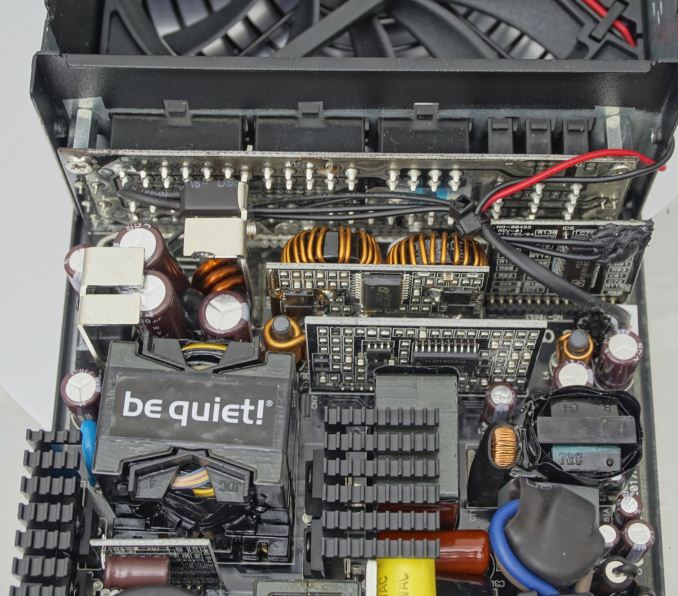
For the testing of PSUs, we are using high precision electronic loads with a maximum power draw of 2700 Watts, a Rigol DS5042M 40 MHz oscilloscope, an Extech 380803 power analyzer, two high precision UNI-T UT-325 digital thermometers, an Extech HD600 SPL meter, a self-designed hotbox and various other bits and parts. For a thorough explanation of our testing methodology and more details on our equipment, please refer to our How We Test PSUs – 2014 Pipeline post.
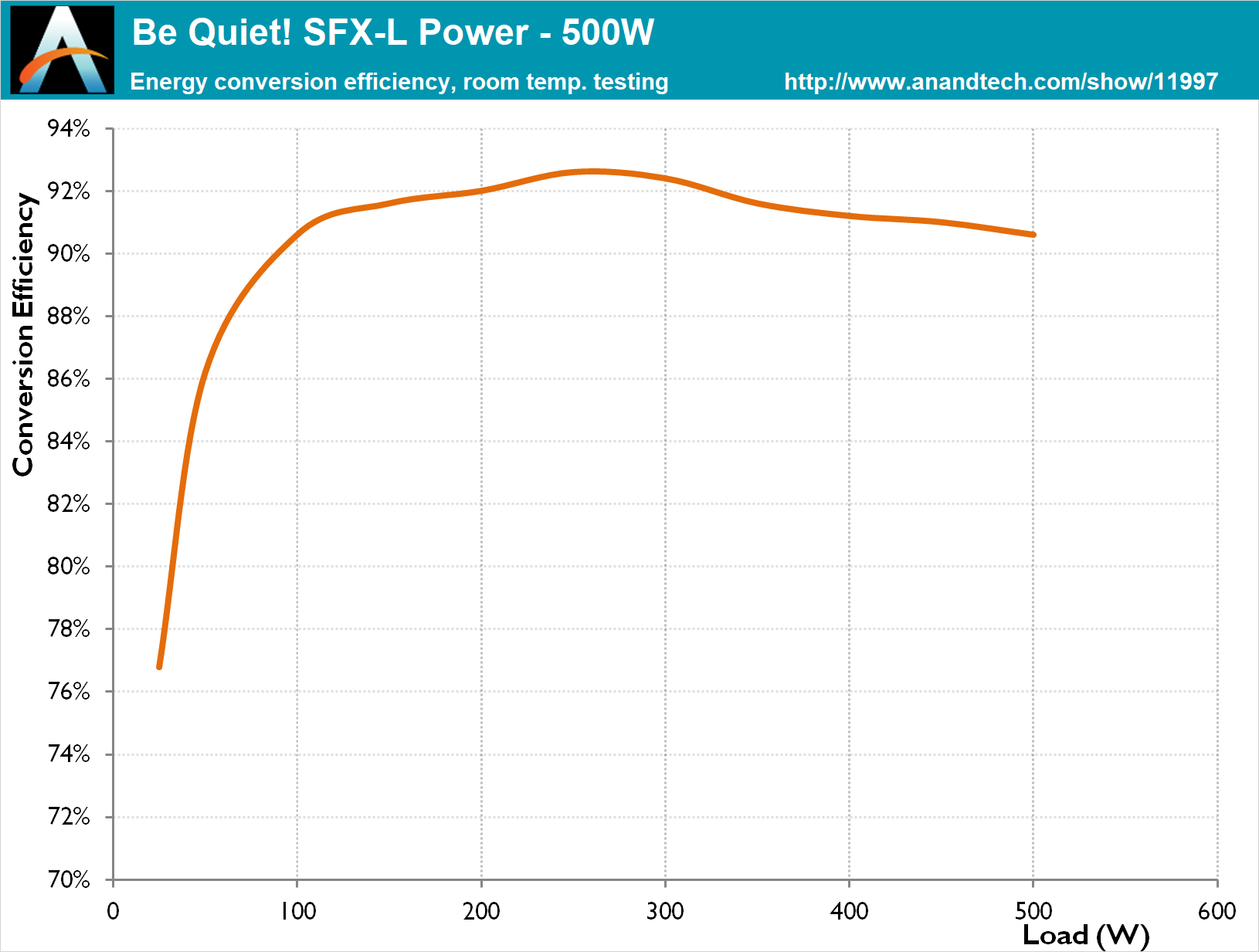
The efficiency of the Be Quiet! SFX-L Power 500W PSU was surprisingly good, even when compared to ATX 80Plus certified models. Across the nominal load range (20% to 100% of the unit’s capacity), the SFX-L PSU meets the 80Plus Gold certification standards with ease. The average efficiency across the nominal load range is 91.5%, which is exceptional for an SFX-L PSU. It also is particularly efficient when handling low loads, with the conversion efficiency surpassing 86% with a load of just 50 Watts.
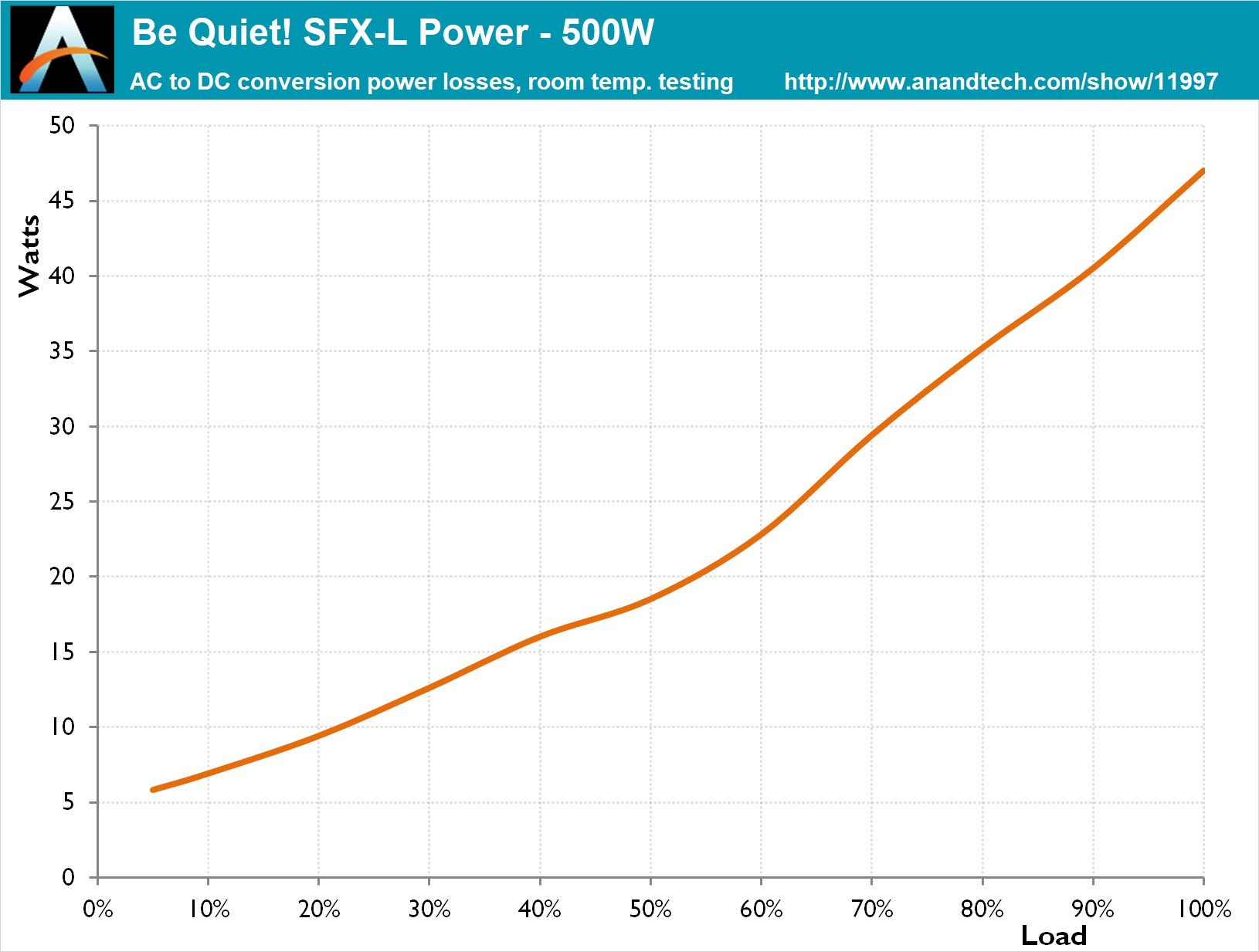
The thermal performance of the Be Quiet! SFX-L Power 500W is very good, rewarding Be Quiet! for their choice to extend the chassis and go with a 120 mm fan. The temperature readings are low, even comparable to those of high-end ATX units, yet not astonishing. The fan’s airflow can only do so much when the heat dissipation surface is limited. Better heatsinks could have a dramatic effect here.
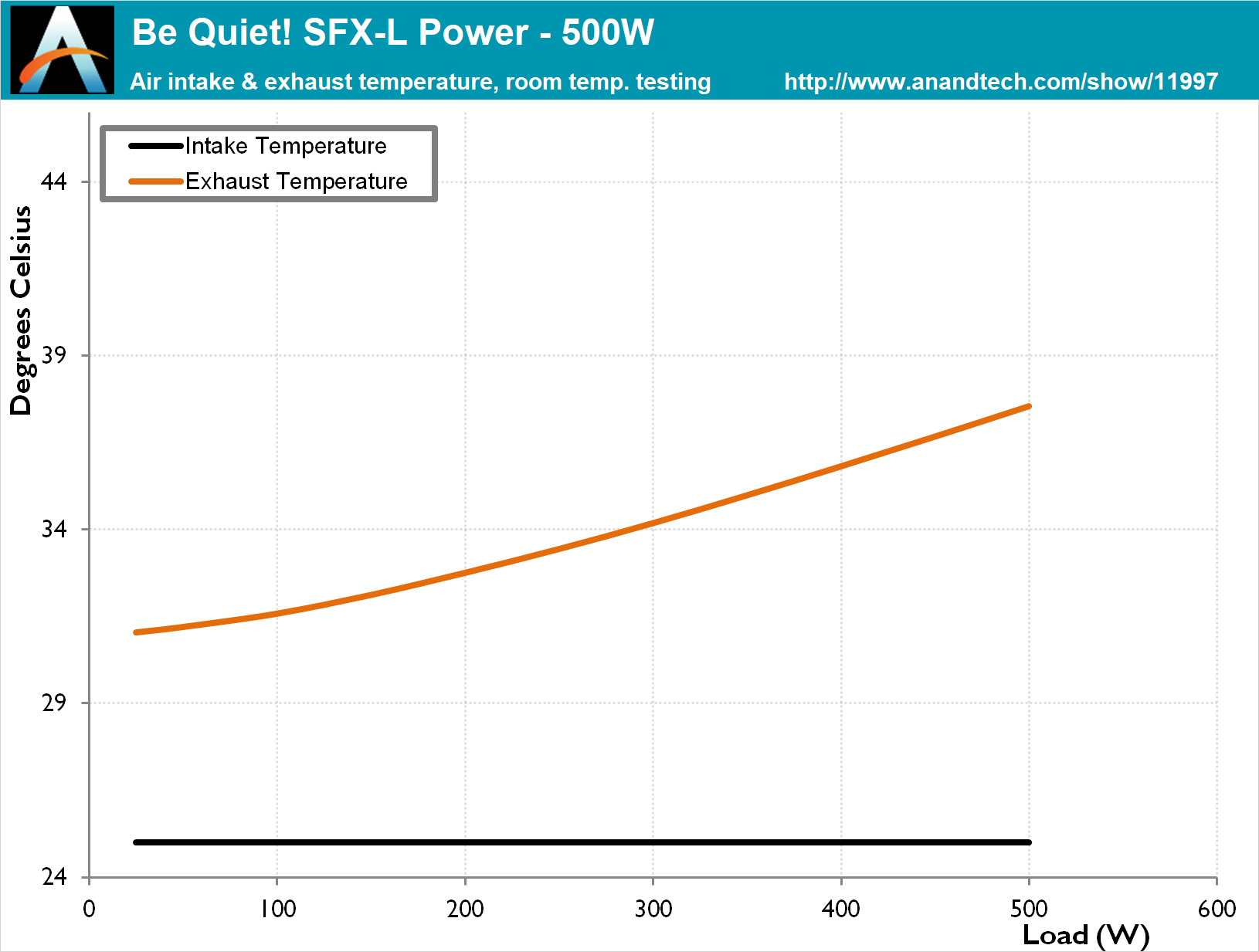
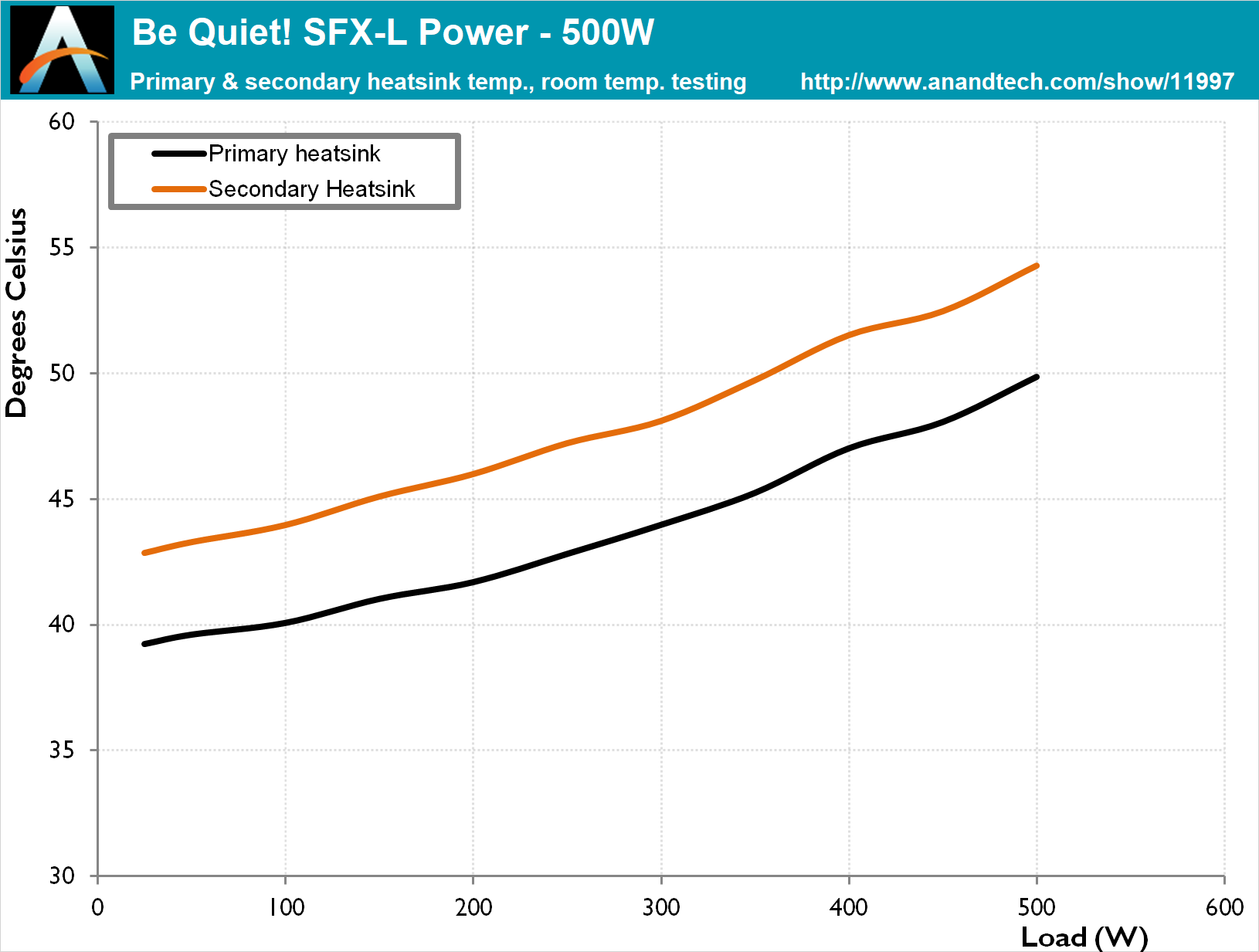
Our sound pressure readings were good but probably not as good as Be Quiet! would have liked them to be. There is no “semi-fanless” mode or advanced thermal control circuitry here – the fan starts immediately alongside with the PSU and its speed depends on the unit’s internal temperature. The Be Quiet! SFX-L Power 500W is practically inaudible at low loads but can be noticed if the entire room is entirely quiet. As the load increases over 300 Watts, the fan will start increasing its speed exponentially, making the PSU clearly audible when heavily loaded.

Earlier SFX PSU designs were notorious for their poor power quality figures. More recent models, like the SilverStone SX700-LPT and the Enermax Revolution SFX 650W, were greatly improved. Sadly, the electrical performance of the Be Quiet! SFX-L Power 500W may not be as bad as that of the earlier models but it definitely is not on par with these newer designs. Voltage regulation is excellent, with the 12V line maintaining a regulation of 1.1% and the 3.3V/5V lines falling only slightly behind at about 1.5%. Power quality however leaves a lot to be desired. While voltage ripple figures are well within the design guide limits, we recorded a maximum of 82 mV, 42 mV and 36 mV on the 12V, 5V and 3.3V lines respectively, figures that are high by today’s standards and uncomfortably close to the directive’s limits. Paradoxically, when the unit is heavily cross loaded, the main 12V line displays a ripple lower than that of the 3.3V/5V lines.
| Main Output |
| Load (Watts) |
100.77 W |
250.97 W |
374.96 W |
498.14 W |
| Load (Percent) |
20.15% |
50.19% |
74.99% |
99.63% |
| |
Amperes |
Volts |
Amperes |
Volts |
Amperes |
Volts |
Amperes |
Volts |
| 3.3 V |
1.71 |
3.36 |
4.29 |
3.35 |
6.43 |
3.33 |
8.57 |
3.31 |
| 5 V |
1.71 |
5.06 |
4.29 |
5.04 |
6.43 |
5.01 |
8.57 |
4.98 |
| 12 V |
7.15 |
12.08 |
17.87 |
12.03 |
26.8 |
11.99 |
35.74 |
11.95 |
| Line |
Regulation
(20% to 100% load) |
Voltage Ripple (mV) |
| 20% Load |
50% Load |
75% Load |
100% Load |
CL1
12V |
CL2
3.3V + 5V |
| 3.3V |
1.5% |
12 |
16 |
24 |
36 |
16 |
40 |
| 5V |
1.6% |
16 |
26 |
30 |
42 |
18 |
42 |
| 12V |
1.1% |
26 |
42 |
50 |
82 |
76 |
36 |
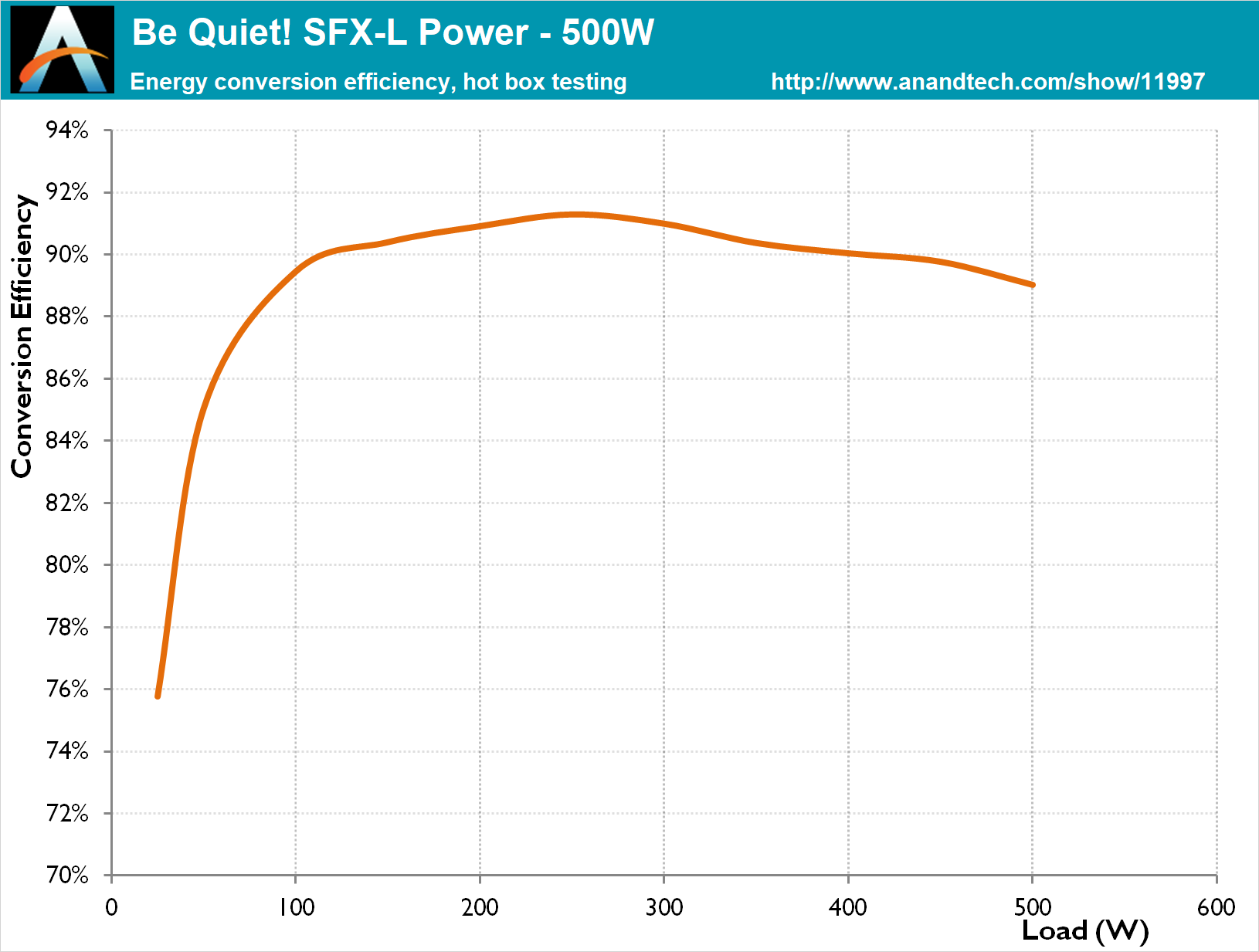
The Be Quiet! SFX-L Power 500W retains its high energy conversion efficiency inside the hotbox, taking only a relatively small performance hit evenly distributed across the entire load range. This indicates that the components are not getting thermally stressed, not even when the unit is heavily loaded under these adverse conditions. The average efficiency reduction is 1.1%, with a drop of 1.5% at 100% load, suggesting that the components are handling the adverse ambient conditions relatively well.
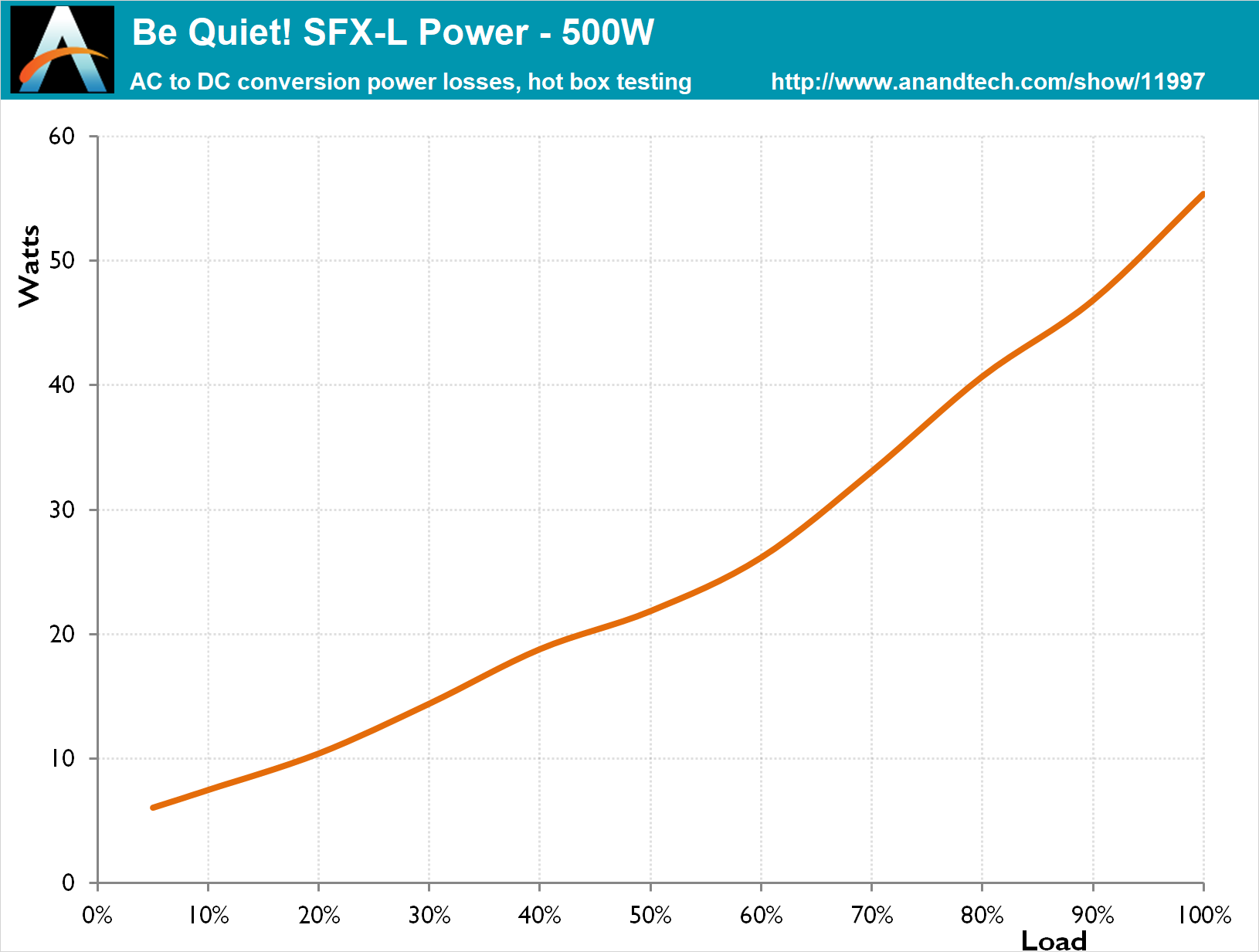
The presence of the 120 mm cooling fan hardly helps the acoustics performance of this PSU when the ambient temperature is very high. It makes the noise levels a little more tolerable when the PSU is heavily loaded, but the PSU will certainly not be quiet under such conditions, not with a load any higher than 100 Watts. Despite the deferential efforts of the cooling fan, the internal temperatures of the Be Quiet! SFX-L Power are relatively high for a PSU with a maximum output of just 500 Watts. With the components not showing any signs of thermal stress and the efficiency holding very well, the obvious culprit here again is the small heatsinks.


As expected, the heatsinks of the SFX-L Power 500W PSU are too small for extreme operating conditions and, thus, the cooling fan is striving to cope with the high cooling requirements. The internal temperatures are kept at safe levels but the PSU is clearly audible even when lightly loaded, with the fan’s noise reaching intolerable levels under high loads. As this unit is rated for operation up to 40 °C, we find these results unsurprising.
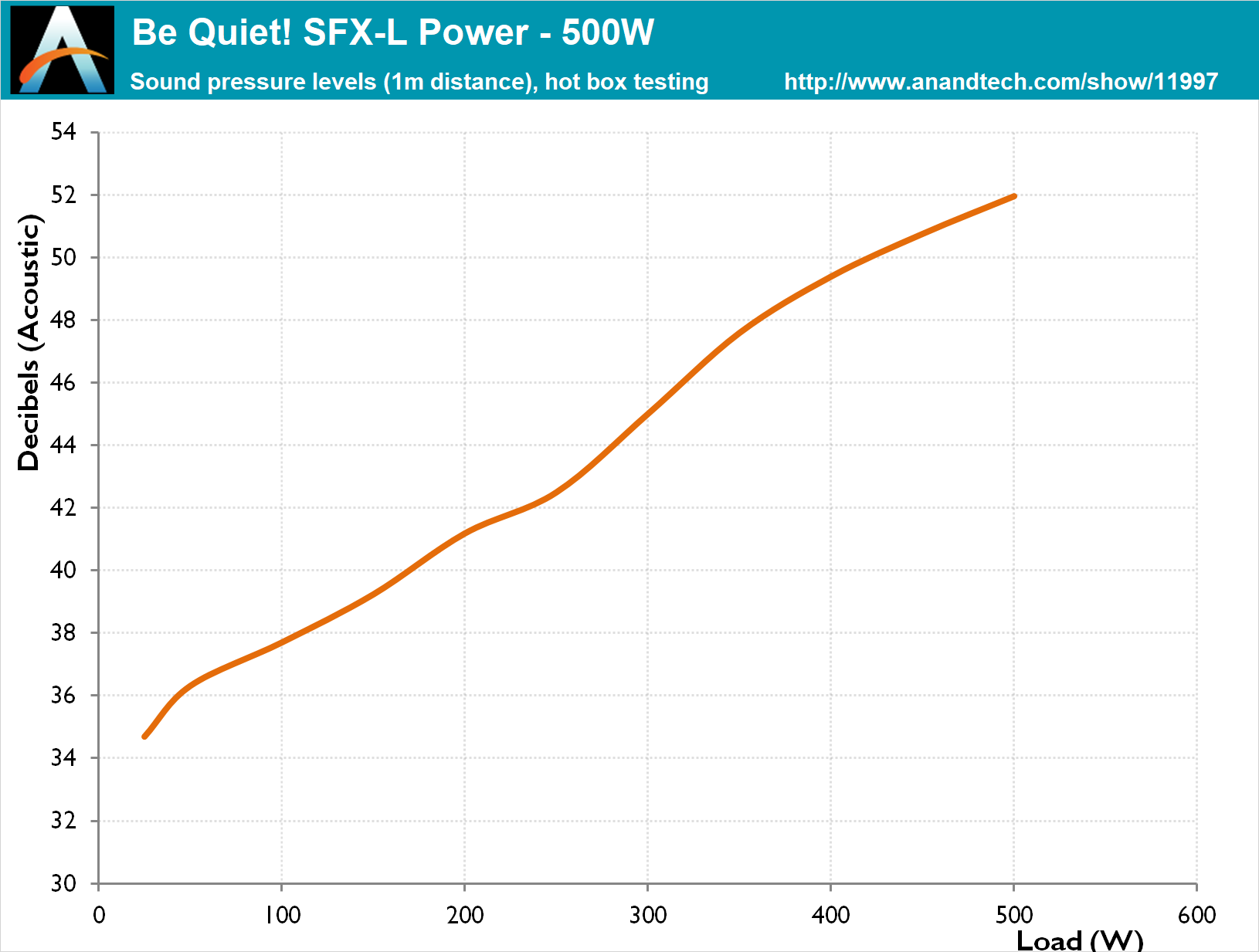
With their latest SFX/SFX-L units, Be Quiet! is trying to balance themselves somewhere inside the boundaries of the mainstream market by designing a reliable product that performs well but, at the same time, is antagonistically priced. SFX PSUs are becoming a significant part of the market share and Be Quiet! obviously wants to entice as many system builders as possible.
The SFX-L Power 500W unit that we reviewed today is a little longer than a standard SFX PSU, limiting its compatibility with some cases and designs, but offering better thermal and acoustics performance for more advanced systems. The presence of four 6+2 pin PCIe connectors also makes it ideal for more advanced gaming systems that have, or may eventually have, more than one graphics card installed. The output of this unit should be able to handle two mainstream cards, yet we definitely do not recommend trying to power two current generation top-tier cards with it. Future generation cards may be more energy-efficient, allowing the SFX-L Power 500W to effortlessly power them.

While its power quality figures could certainly use an improvement, they are well within the design guideline limits. OEM High Power’s designs rarely are great performers when it comes to line filtering, so the relatively high voltage ripple was not surprising. On the other hand, the energy conversion efficiency of the SFX-L Power 500W PSU is excellent, easily meeting the 80Plus Gold certification standards. The PSU also displayed exceptional low load efficiency performance during our testing, which is particularly good for systems that stay on 24/7, such as, for example, NAS or NVR servers.
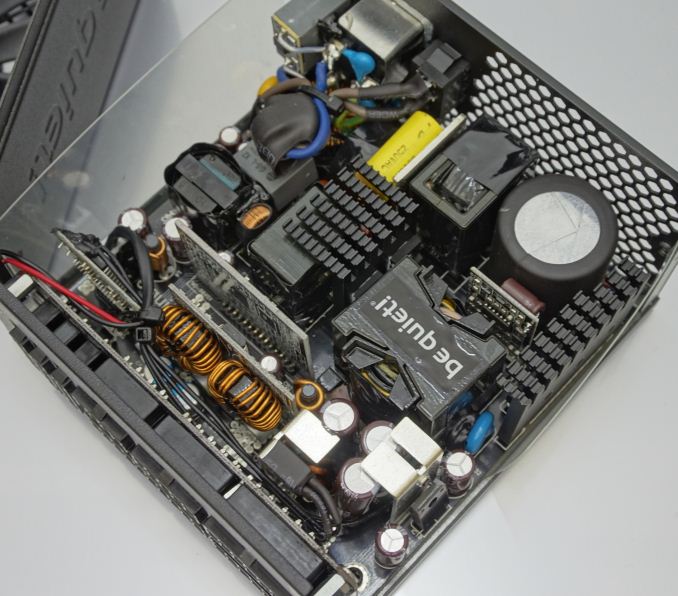
The marketing focus of the SFX-L Power 500W PSU, and nearly of all PSUs that the company retails, is low-noise operation. The concept of elongating the chassis and using a 120 mm is also based on the improvement of the unit’s thermal performance and, in extent, lower noise operation. While the SFX-L Power 500W definitely is not loud, we feel that Be Quiet! failed their supporters here by not implementing a semi-fanless control mode. The high efficiency of the SFX-L Power 500W could allow it to easily output hundreds of watts before active cooling became necessary, even with its currently undersized heatsinks. Other than that, the thermal performance of the SFX-L Power 500W is good but has room for improvement, as the cooling capabilities of the unit are hindered by the small heatsinks, resulting to high noise levels when the PSU is heavily loaded.
The retail price of the SFX-L Power 500W at the time of this review is $ 100, which is reasonable for a quality 80Plus Gold certified SFX 500W PSU. It comes with a three years manufacturer warranty, which is alright but, again, not impressive by today’s standards. We feel that the Be Quiet! SFX-L Power 500W is without a trump card against the several other SFX PSUs now available around that price, which limits the market potential considerably. It is not by any means a bad SFX-L PSU but, at the same time, it is unimpressive. We believe that if it had a semi-fanless mode or perhaps a longer warranty, it could convince a significantly larger percentage of users.



